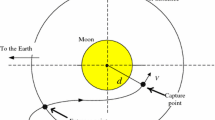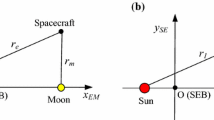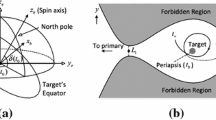Abstract
Gravitational capture is a useful phenomenon in the design of the low energy transfer (LET) orbit for a space mission. In this paper, gravitational lunar capture based on the Sun–Earth–Moon bicircular model (BCM) in the restricted four body problem is studied. By the mechanical analysis in the space near the Moon, we first propose a new parameter \(k\), the corrected ratio of the radial force, to investigate the influence of the radial force on the capture eccentricity in the BCM. Then, a parametric analysis is performed to detect the influences on the corrected ratio \(k\). Considering the restriction of time-of-flight and corrected ratio, we investigate, respectively, the minimum capture eccentricity and the corrected minimum capture eccentricity. Via numerical analysis, we discover two special regions on the sphere of capture, in which the capture point possesses the global minimum capture eccentricity and corrected capture eccentricity. They denote the optimal capture regions in terms of minimizing the fuel consumption of the maneuver. According to the results obtained, some suggestions on the design of the LET orbit are given.

















Similar content being viewed by others
References
Andreu, M.A.: Preliminary study on the translunar halo orbits of the real Earth–Moon system. Celest. Mech. Dyn. Astron. 86(2), 107–130 (2003)
Astakhov, S., Burbanks, A., Wiggins, S., Farrelly, D.: Order and chaos in stellar and planetary systems. In: ASP Conference Series, vol. 316, 80–85 (2004)
Bate, R.R., Mueller, D.D., White, J.E.: Fundamentals of Astrodynamics, pp. 333–334. Dover, New York (1971)
Belbruno, E.A.: Lunar capture orbits, a method of constructing Earth Moon trajectories and the lunar GAS mission. AIAA-87-1054. In: 19th AIAA/DGLR/JSASS International Electric Propulsion Conference, Colorado Springs, CO (1987)
Belbruno, E.A.: Examples of the nonlinear dynamics of ballistic capture and escape in the Earth–Moon system. AIAA-90-2896. In: AIAA Astrodynamics Conference, Portland, OR (1990)
Belbruno, E.A.: Ballistic lunar capture transfer using the fuzzy boundary and solar perturbations: a survey. In: Proceedings for the International Congress of SETI Sail and Astrodynamics, Turin, Italy (1992)
Belbruno, E.A., Miller, J.K.: A Ballistic Lunar Capture Trajectory for Japanese Spacecraft Hiten. Jet Propulsion Lab, JPL IOM 312/90.4-1731, Internal Document, Pasadena, CA (1990)
Castelli, R.: Regions of prevalence in the coupled restricted three-body problems approximation. Commun. Nonlinear Sci. Numer. Simul. 17(2), 804–816 (2012)
Castellà, E., Jorba, À.: On the vertical families of two-dimensional tori near the triangular points of the bicircular problem. Celest. Mech. Dyn. Astron. 76(1), 35–54 (2000)
Circi, C., Teofilatto, P.: Effect of planetary eccentricity on ballistic capture in the solar system. Celest. Mech. Dy. Astron. 93, 69–86 (2005)
Fantino, E., Gomez, G., Masdemont, J.J., Ren, Y.: A note on libration point orbits, temporary capture and low-energy transfers. Acta Astronaut. 67, 1038–1052 (2010)
Hamilton, D.P., Burns, J.A.: Orbital stability zones about asteroids. II—the destabilizing effects of eccentric orbits and of solar radiation. Icarus 96, 43–64 (1992)
Hyeraci, N., Topputo, F.: Method to design ballistic capture in the elliptic restricted three-body problem. J. Guid. Control Dyn. 33(6), 1814–1823 (2010)
Krish, V., Belbruno, E.A., Hollister, W.M.: An investigation into critical aspects of a new form of low energy lunar transfer, the Belbruno–Miller trajectories. In: Proceedings of the AIAA/AAS Astrodynamics Conference, AIAA, Washington, DC, pp. 435–444 (1992)
Machuy, A.L., Prado, A.F.B.A., Stuchi, T.J.: Numerical study of the time required for the gravitational capture in the bi-circular four-body problem. Adv. Space Res. 40, 118–124 (2007)
Prado, A.F.B.A.: Numerical study and analytic estimation of forces acting in ballistic gravitational capture. J. Guid. Control Dyn. 25(2), 368–375 (2002)
Prado, A.F.B.A.: Numerical and analytical study of the gravitational capture in the bicircular problem. Adv. Space Res. 36, 578–584 (2005)
Prado, A.F.B.A., Vieira Neto, E.: Study of the gravitational capture in the elliptical restricted three-body problem. J. Astronaut. Sci. 54(3 & 4), 567–582 (2006)
Qi, R., Xu, S.J., Zhang, Y., Wang, Y.: Earth-to-Moon low energy transfer using time-dependent invariant manifolds. In: AIAA/AAS Astrodynamics Specialist Conference, Minneapolis, MN (2012)
Simó, C., Gómez, G., Jorba, À., Masdemont, J.: The Bicircular Model Near the Triangular Libration Points of the RTBP. From Newton to Chaos, NATO ASI Series, pp. 343–370 (1995)
Vieira Neto, E., Prado, A.F.B.A.: Time-of-flight analyses for the gravitational capture maneuver. J. Guid. Control Dyn. 21(1), 122–126 (1998)
Yamakawa, H.: On Earth–Moon Transfer Trajectory with Gravitational Capture. Ph.D. Dissertation, University of Tofyo (1992)
Zanzottera, A., Mingotti, G., Castelli, R., Dellnitz, M.: Intersecting invariant manifolds in spatial restricted three-body problems: design and optimization of Earth-to-halo transfers in the Sun–Earth–Moon scenario. Commun. Nonlinear Sci. Numer. Simul. 17(2), 832–843 (2012)
Author information
Authors and Affiliations
Corresponding author
Rights and permissions
About this article
Cite this article
Qi, Y., Xu, S. & Qi, R. Gravitational lunar capture based on bicircular model in restricted four body problem. Celest Mech Dyn Astr 120, 1–17 (2014). https://doi.org/10.1007/s10569-014-9554-7
Received:
Revised:
Accepted:
Published:
Issue Date:
DOI: https://doi.org/10.1007/s10569-014-9554-7




